In our pursuit of a healthier lifestyle, the role of polyphenols in our diet has garnered significant attention, standing at the forefront of clinical nutrition and food science. These powerful dietary antioxidants found abundantly in plant foods like fruits, vegetables, and green tea, and even in delights such as dark chocolate and red wine, are celebrated for their antioxidant capacity and potential to ward off various diseases, including cardiovascular and neurodegenerative conditions. However, the journey from farm to table is fraught with hurdles that can diminish the polyphenol content of these nutritious foods. Factors such as the cooking process, storage conditions, and food processing techniques play pivotal roles in preserving or destroying these bioactive compounds, making understanding "what destroys polyphenols" crucial for anyone aiming to optimize their health benefits.
From boiling water to stir-frying in a stainless steel pan, how we prepare our meals significantly influences our food's antioxidant activity and total polyphenol levels. Similarly, the choice between consuming raw samples or cooked vegetables, the decision to peel or not, and even the storage method can drastically impact the phenolic content and, consequently, our dietary antioxidant benefits. This article delves into how different cooking methods, food processing, and storage practices can degrade or enhance the polyphenol content in selected green vegetables, fruits, and other plant-based foods. With a focus on preserving the radical scavenging activity of these compounds, we'll explore strategies to maintain a diet rich in polyphenols, thereby supporting cardiovascular health, cognitive health, and overall well-being.
Key Takeaways
- Cooking methods like boiling, steaming, frying, and microwaving each have a distinct impact on food's polyphenol content; some methods can lead to significant losses of these antioxidant compounds, while others may preserve or even enhance them.
- Food processing techniques such as encapsulation and nonthermal technologies can help preserve polyphenols. In contrast, common practices like peeling can lead to substantial losses of polyphenols, often concentrated in the outer layers of fruits and vegetables.
- Storage conditions, including light exposure, temperature, and humidity, influence the degradation of polyphenols, making proper storage critical to maintaining the antioxidant capacities of plant-based foods.
The Impact of Cooking Methods on Polyphenols
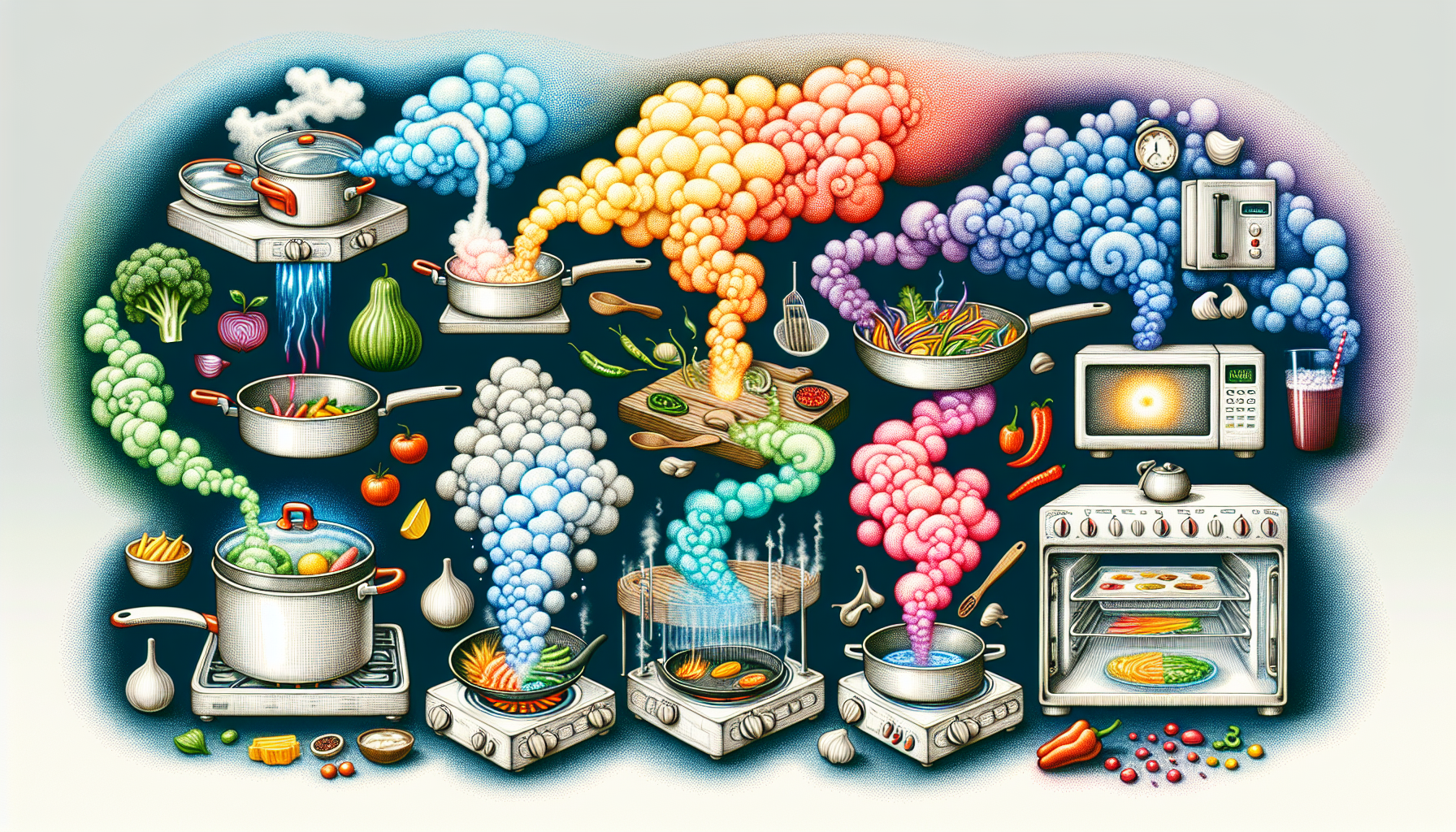
The quest for good health often leads us to the kitchen, where the cooking methods we choose wield great influence over the nutrient profile of our meals. It’s a dance of temperatures and techniques where our food's antioxidant capacity and phenolic content can flourish or fade. Whether you’re a beginner in the kitchen or an experienced chef, it’s crucial to comprehend how various cooking methods affect the valuable polyphenols in your ingredients. After all, these plant-derived compounds are the valiant dietary antioxidants that combat oxidative stress and contribute to our overall well-being.
Not only do boiling, steaming, frying, and microwaving transform raw ingredients into tasty dishes, but these methods also determine the polyphenol content on our plate. While the antioxidant properties of these compounds are celebrated, their sensitivity to heat and processing poses a challenge. Although the cooking process seems to be a harmless step in meal preparation, it can curtail the antioxidant activities of phenolic acids and other polyphenol oxidase enzymes, reducing the total polyphenols and, as a result, their health benefits.
However, not all cooking methods are created equal. Some, like steaming, have been shown to preserve and even enhance the antioxidant capacities of certain foods. Others, like boiling, can exact a harsh toll on the polyphenol levels, especially regarding water-soluble compounds. Frying, with its high temperatures and prolonged heat exposure, can degrade these antioxidant compounds, while the rapid action of microwaving can spare them from destruction. Each technique has its own set of rules in the game of preserving plant polyphenols.
As we further explore the intricacies of cooking procedures, remember that the aim isn’t to entirely evade heat but rather to control it skillfully. To cook is to wield control over the transformation of food, and with a few strategic choices, we can ensure that our dietary antioxidants are not casualties in the process. It’s about discovering the perfect balance between taste and nutrition, ensuring the antioxidant effects of our meals are not undermined but rather appreciated.
Boiling
The rolling boil of water in a pot is a familiar sight in kitchens worldwide, a testament to one of the most common cooking methods. But beneath the surface, a battle rages against polyphenols, those antioxidant warriors that defend our cells. Boiling can lead to significant losses, particularly water-soluble polyphenols, with up to 80% being destroyed in some polyphenol-rich foods. This heat treatment, while effective for cooking, is a double-edged sword, capable of extracting or eroding our favorite vegetables' phenolic content.
Take kale and white cabbage, for example. In the grand tapestry of cooking processes, these vegetables stand out, their polyphenolic content increasing after a blanching session in boiling water. The thermal treatment may break down complex polyphenolic compounds, making them more available. Yet, this is not a universal rule. For every kale and cabbage triumph, there are countless other vegetables where boiling equates to a loss in bioactive constituents and a reduction in major bioactive and antioxidant activities, especially in leafy vegetables.
A domestic kitchen is a place of transformation, where the boiling water can turn raw to cooked, crisp to tender, and, unfortunately, polyphenol-rich to polyphenol-poor. The hard truth is that many foods we are subject to boiling, including shallots and other flavorful ingredients in our dishes, may have reduced antioxidant properties. As the steam rises, so does the likelihood of polyphenol degradation, a silent sacrifice in pursuing culinary perfection.
While boiling is a flexible and indispensable aspect of cooking, it necessitates a considerate approach. We must consider the trade-offs and weigh the convenience and tradition against the potential nutritional losses. By adjusting our cooking procedures, perhaps opting for a quick blanch rather than a prolonged boil or choosing to steam where possible, we can take steps to preserve our foods' polyphenol content and antioxidant capacities. It’s a straightforward change that can significantly impact the quest for a healthier diet.
Steaming
Amidst the spectrum of cooking methods, steaming emerges as a beacon of hope for polyphenol preservation. This gentle process, often conducted in a stainless steel pan or a specialized steamer, is revered for its ability to retain the nutritional integrity of foods. Compared to the aggressive heat treatments of boiling or frying, steaming stands out as a method that not only preserves but can also enhance the total polyphenolic content in certain vegetables. Some benefits of steaming include:
- Retaining more vitamins and minerals compared to other cooking methods
- Preserving the natural color and texture of vegetables
- Enhancing the flavor of foods without the need for added fats or oils
By incorporating steaming into your cooking routine, you can ensure that you maximize the health benefits of your meals.
A case in point is the red radish, a humble yet vibrant addition to any plate, whose polyphenol levels can rise like the steam that cooks it. Broccoli, too, shares this benefit, its antioxidant activities seemingly invigorated by the steam cooking process. This significant finding shifts our perception of cooking from a potential threat to polyphenols to a protective ally. Indeed, these steamed samples represent a triumph, a testament to the fact that heat treatment need not be synonymous with nutrient loss.
The cooking process of steaming offers several benefits:
- It envelops foods in moist warmth, coaxing their flavors while safeguarding their bioactive compounds from degradation.
- Unlike boiling water, which can leach out soluble nutrients, the steam ensures that the antioxidant compounds remain within the food, ready to be absorbed by our bodies.
- It aligns with our health goals, allowing us to enjoy the full benefits of plant foods, mainly green vegetables.
Hence, steaming isn’t merely a cooking method; it’s a calculated choice, a purposeful act of culinary preservation. It beckons us to rethink our approach to heat treatment, to embrace the steam that rises not as a sign of nutrient loss but as a promise of preserved polyphenol levels. As we explore different cooking methods, let us not overlook the simple yet powerful act of steaming, which can unlock our food's antioxidant capacities without compromise.
Frying and Microwaving
When it comes to frying, the sizzle in the pan tells a story of transformation but also one of potential loss. The high heat and prolonged cooking times inherent to frying can lead to a significant degradation of polyphenols. While capable of creating irresistibly crispy textures and rich flavors, this cooking method often does so at the expense of the antioxidant content in fruits and vegetables. It’s a culinary trade-off where the immediate sensory pleasures might overshadow the long-term health benefits of polyphenols.
On the opposite side of the spectrum lies microwaving, a modern marvel of food science that offers a reprieve for polyphenols. Thanks to its short cooking times and reduced heat exposure, microwaving is a guardian of these antioxidant compounds. It’s a cooking process that respects the delicate nature of polyphenols, ensuring that cooked vegetables retain their bioactive constituents more effectively than some traditional cooking methods.
The comparison between frying and microwaving highlights a broader theme within domestic cooking: the relationship between heat treatment and nutrient preservation. Steaming and frying can offer better retention of polyphenols when juxtaposed with boiling, but microwaving emerges as a champion of convenience and preservation. Microwaving is an unanticipated champion in the mission to retain the antioxidant activities in our food, offering a method that suits the rapid pace of contemporary life without sacrificing nutritional quality.
As we navigate the landscape of cooking procedures, we must recognize that each method carries its own implications for polyphenol content. By making judicious choices, we can guarantee that our stir-fried dishes and microwaved meals excite our tastebuds and nourish our bodies. It’s a balancing act that requires us to weigh the pleasures of the palate against the fortitude of our food’s antioxidant properties.
Food Processing and Polyphenol Destruction
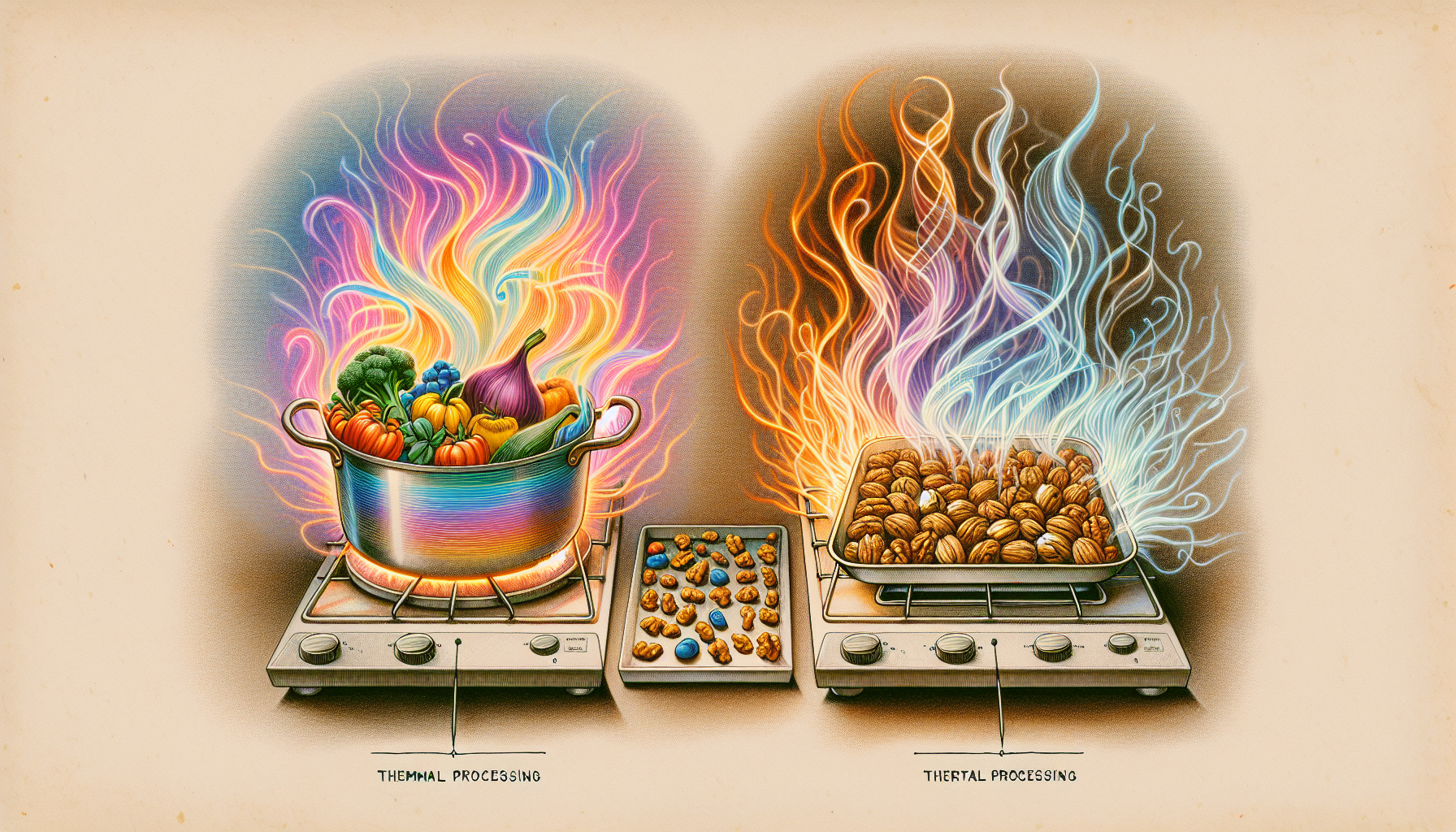
Transitioning from the stovetop to the broader realm of food processing, we encounter a myriad of techniques that can either champion or challenge the stability of polyphenols. In the pursuit of convenience and longevity, food science has developed processes that, while extending shelf life, can inadvertently degrade the phenolic compounds we value for their antioxidant properties. Thermal processing, in particular, is a formidable opponent, with high temperatures often leading to the breakdown of these sensitive compounds, diminishing the antioxidant activity and polyphenol levels in our plant foods.
However, not all hope is lost in the fight to conserve polyphenols during food processing. Encapsulation technologies, such as hydroxypropyl-β-cyclodextrin, have emerged as shields, enhancing the thermal stability of polyphenols and safeguarding them during processes involving heat. Similarly, nanoliposomes offer a protective embrace, increasing polyphenols' stability and antioxidant activities during storage. These advanced techniques embody a harmonious mix of culinary tradition and modern science, ensuring our polyphenol consumption isn’t hindered by the processes intended to make food available at our tables.
Roasting, a process beloved for the rich flavors it imparts, can be a double-edged sword for polyphenols, particularly in roasting cocoa beans. The high temperatures can significantly reduce polyphenol concentrations, leading to innovative approaches like producing chocolates from unroasted beans. These chocolates retain a higher concentration of polyphenols, demonstrating that even in processing, there are choices to be made that can influence the antioxidant capacities of the foods we consume.
Yet, it’s not just about avoiding heat. Nonthermal technologies, such as cold plasma treatment, are emerging as champions for polyphenol-rich foods' nutritional quality and sensory characteristics. These methods preserve the antioxidant compounds without the need for high temperatures, offering a promising avenue for maintaining the health benefits of our dietary antioxidants. As we examine the effect of food processing on polyphenols, it becomes evident that innovation and tradition can coexist, providing a way to relish our favorite foods without giving up their nutritional richness.
Freezing and Cooling
A deep chill descends upon our food as we explore the realms of freezing and cooling, where the state of suspended animation offers a refuge for polyphenols. This non-invasive method is a testament to the power of low temperatures in effectively preserving these bioactive compounds' structure and content. Even as the world outside continues its relentless march, within the confines of the freezer, polyphenols remain steadfast, their antioxidant properties shielded from the ravages of time and temperature.
Cooling and freezing stand as sentinels, maintaining the stability of polyphenols and, in some instances, potentially enhancing their content. This preservation process contradicts the typical narrative of nutrient degradation, implying that cold temperatures may not just preserve but also enhance the health benefits of our food. This is particularly evident in the case of strawberries, where rapid freezing has been shown to retain higher levels of monomeric anthocyanins compared to their slowly frozen counterparts, illuminating the importance of freezing rate in polyphenol preservation.
Rapid freezing, with its swift descent into the frigid depths, minimizes alterations and enzymatic activities that could otherwise degrade polyphenols. It’s an approach that mirrors the swift and decisive action needed to protect these compounds from the environmental forces that seek to diminish their antioxidant activities. It’s not just about locking away the freshness; it’s about locking in the nutritional value, ensuring that the polyphenols within remain potent and ready to contribute to our health.
As we navigate the intricate relationship between polyphenols and the cooking process, we must not neglect the silent guardian that is freezing. Its method requires little more than pushing a button, yet its impact on preserving polyphenols is profound. Whether it’s the rapid freezing of fruits or the careful cooling of prepared meals, these techniques offer a simple yet effective way to ensure that our dietary antioxidants endure, ready to serve our bodies when the thaw finally comes.
Fermentation
Fermentation is an ancient ally in the culinary world, a transformative process that enriches flavors and redefines the chemical structure of polyphenols. Through the meticulous work of enzymes such as tannases and glycosidases, fermentation can enhance the stability of these compounds, leading to increased bioavailability and higher biological activity. It’s a natural alchemy where the ordinary is reborn with newfound potency, providing us with foods that boast improved antioxidant and health-promoting properties.
The fermentation process is a dance of microorganisms and organic compounds, resulting in the biotransformation of polyphenols that make them more accessible to our digestive systems. Foods that have undergone this metamorphosis, such as red wine and fermented soy products, are a pleasure to consume and a source of smaller, more absorbable phenolic acids. This improved bioavailability means that our bodies can more effectively utilize the antioxidant activities of polyphenols, tapping into their potential to combat neurodegenerative and cardiovascular diseases.
Yet, fermentation is not simply a story of enhancement; it’s a narrative of change. While the total phenolic content may sometimes decrease, the overall antioxidant activity can increase, a paradox that underscores the complexity of this process. The cell walls of plant-based foods break down, releasing free soluble phenolic compounds that, although smaller in number, are mighty in their radical scavenging activity. This serves as a reminder that sometimes, less can indeed be more.
Embracing fermented foods is to embrace a legacy of health and flavor passed down through generations, a practice that has stood the test of time. As we incorporate these foods into our diet, we honor tradition and offer our bodies the protective effects of transformed polyphenols.
Fermentation, with its ability to amplify these compounds' antioxidant, anti-inflammatory, and antimicrobial activities, stands as a testament to the wisdom of our ancestors and the enduring power of nature’s preservation method.
Peeling and Polyphenol Loss
Peeling fruits and vegetables is a ritual in many kitchens, a preparatory step taken without much thought. Yet, this seemingly innocuous act can have profound consequences for the polyphenol content of our foods. Often discarded and overlooked, the peels are bastions of antioxidant compounds, including phenolic acids and other bioactive constituents. By discarding them, we unintentionally remove a substantial part of the food’s nutritional value, denying ourselves the compounds that can strengthen our antioxidant defenses.
The contrast is stark: antioxidant levels in peels can be up to 328 times higher than in the pulp, a staggering difference highlighting these outer layers' importance. This is not merely a slight reduction in nutrient intake but a substantial loss of potential health benefits.
Eating unpeeled fruits and vegetables can significantly increase our intake of:
- fiber
- vitamins
- minerals
- antioxidants
This contributes to the total antioxidant capacity of our diet and enhances our overall health.
The implications of peeling extend beyond individual nutrient levels; they touch on the broader concept of food waste and the undervaluing of whole foods. Most fruit and vegetable peels are edible and packed with nutrients, and by consuming them, we can increase our antioxidant intake. The decision to peel or not to peel becomes a question of priorities: do we value convenience and aesthetics over our food's antioxidant effects and health benefits?
As we become more conscious of the choices we make in the kitchen, let us reconsider the habit of peeling. By embracing unpeeled produce's natural textures and flavors, we can enjoy a richer, more diverse intake of antioxidant compounds. It’s a simple change that aligns with a healthy diet and reflects a deeper appreciation for all our plant foods. In this way, we can ensure that our meals' antioxidant activities are preserved and celebrated in their most complete and nourishing form.
The Role of Food Storage on Polyphenol Degradation
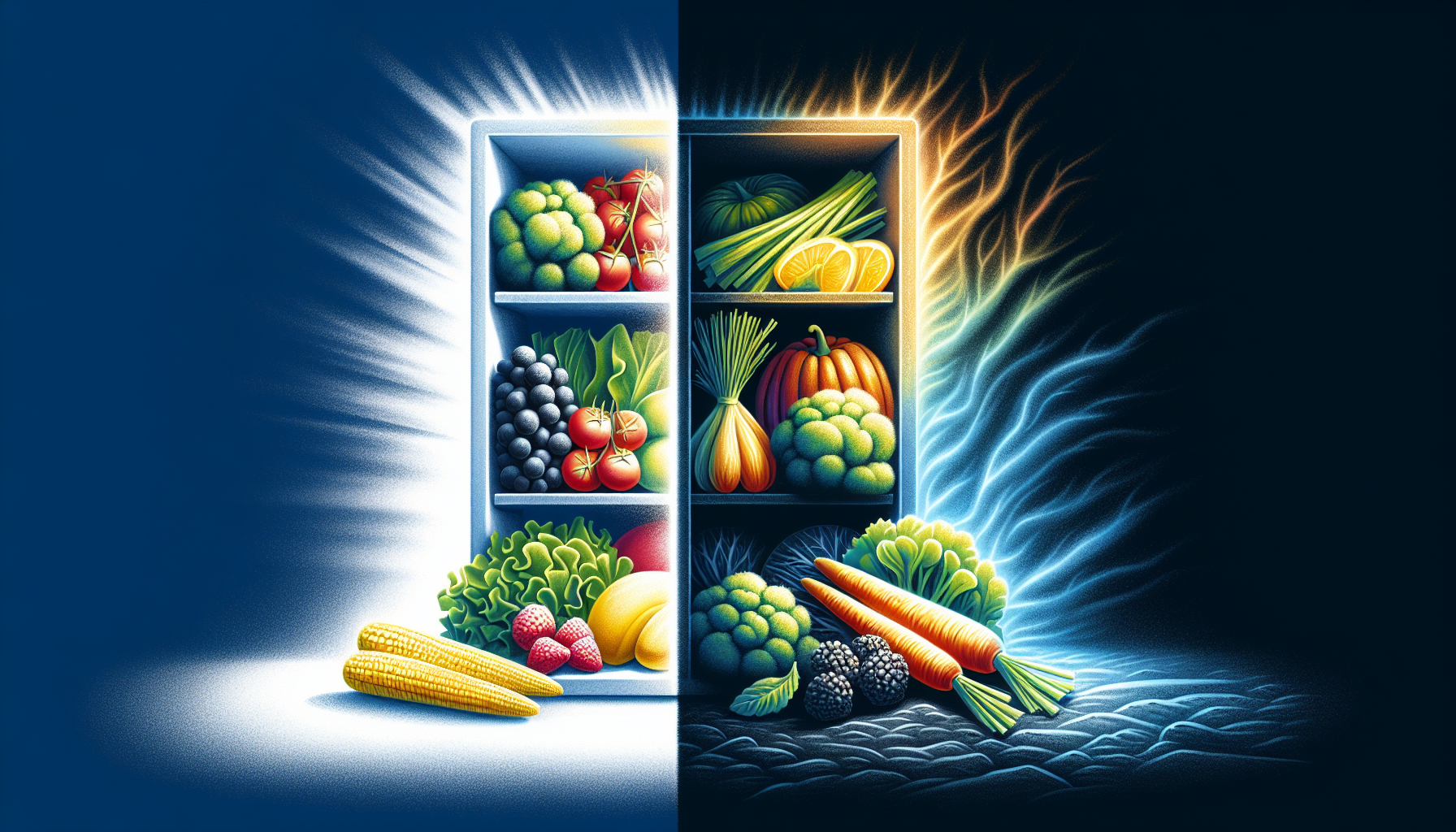
As we move from preparation to preservation, how we store our food emerges as a critical factor in maintaining the integrity of polyphenols. While robust in their health benefits, these antioxidant compounds are vulnerable to the environmental conditions of storage. Light, temperature, and humidity can collectively result in the degradation of polyphenols, reducing the antioxidant capacities of our plant-based foods. Understanding the role of storage in polyphenol degradation is crucial for anyone seeking to maximize the dietary antioxidants in their food.
Research has shown that storage time can leave an indelible mark on the phenolic content of foods such as whole wheat flour. Here are some key findings:
- Total polyphenol content and antioxidant activity decrease after several weeks of storage.
- However, the relationship between phenolic acids and storage is not always straightforward.
- Occasional increases in antioxidant potential can occur, highlighting the complex interactions at play during the storage period.
The degradation of polyphenols during storage is not uniform across all compounds. The polyphenol oxidase activity can significantly decrease specific categories like hydroxycinnamic acids, which are essential to the antioxidant content of foods. Yet, the antioxidant activities of other phenolic compounds might increase, indicating that no single polyphenol is entirely stable or prone to degradation. This variability underscores the importance of understanding the specific polyphenol profile of each food and tailoring storage conditions to preserve these valuable compounds.
Even berry jams, which undergo considerable polyphenol degradation during storage, maintain some antioxidant activity. This resilience suggests that we can mitigate the loss of these healthful compounds with proper storage techniques. By recognizing the delicate balance between polyphenol stability and the environmental factors of storage, we can make informed decisions that prolong our food's antioxidant effects and health benefits.
Light Exposure
The impact of light on polyphenols is akin to the effect of the sun on delicate skin; just as exposure can cause damage, so too can light lead to the degradation of these antioxidant compounds. Anthocyanins, polyphenols responsible for the vibrant colors in many fruits and vegetables, are particularly susceptible to light. Their degradation can affect not only the nutritional quality of the product but also its aesthetic appeal, leading to a significant difference in both health benefits and consumer desirability.
Simply minimizing light exposure can be an effective strategy for preserving the polyphenol content of fresh produce. By storing foods away from direct sunlight or under cover, we can slow the degradation process, ensuring that the antioxidant capacities of our fruits and vegetables are not prematurely diminished. It’s a matter of creating an environment where polyphenols can remain stable, protecting the health benefits they offer.
The influence of light on food is not limited to fresh produce; it also extends to processed products. For example, the storage of olive oil, a product renowned for its polyphenol content and health benefits, should be in dark bottles or cans to prevent light-induced degradation. This consideration of light exposure is essential for maintaining the antioxidant properties of the food we consume and the efficacy of the polyphenols.
By becoming more mindful of how we store our food, we can enhance the longevity and potency of the antioxidant compounds it contains. Light exposure may seem minor, but its impact on polyphenol degradation is significant. As we strive to maintain the highest nutritional value in our diets, let us not overlook the power of darkness in preserving the light of good health within our foods.
Temperature and Humidity
The intricate interaction between temperature, humidity, and polyphenol stability is like a complex dance, where each factor must be finely tuned to sustain our food's physical characteristics and health benefits. Freezing has long been recognized as an effective method to preserve polyphenols, with low temperatures acting as a barrier against the enzymatic activities that lead to degradation. Rapid freezing, in particular, stands as a preservation champion, ensuring that the polyphenols within remain as potent as the day they were ensnared by the cold.
The freezing rate is critical, with fast freezing rates offering a better shield against alterations that can compromise the antioxidant activities of polyphenols. This rapid transition to a frozen state is akin to a moment captured in time, locking in the nutritional value and preventing the slow creep of degradation that can occur with more gradual temperature changes. It’s a process that respects the delicate nature of these compounds, ensuring that they are available to enhance our health when we choose to consume them.
Temperature and storage time are deeply intertwined, influencing the stability of polyphenols such as anthocyanins in preserved products like jams. Optimal storage temperatures, such as a consistent four °C, are recommended to reduce degradation, a reminder that even preservation requires precision and care. It’s about creating an environment where polyphenols can endure, protected from the fluctuations that might otherwise erode their antioxidant potential.
Moisture content, too, plays a pivotal role in the stability of phenolic compounds. Excess humidity can provoke changes in total flavonoid content and antioxidant activity, making controlled humidity a critical aspect of food storage. Proper handling, including refrigeration, is vital to maintaining the polyphenol content of fruits and vegetables. This ensures that these plant-based foods continue offering their full health benefits long after being harvested.
Choosing Foods with High Polyphenol Content

Armed with the knowledge of preserving polyphenols through cooking and storage, we focus on selecting foods naturally rich in these potent compounds. A diverse array of high-polyphenol foods includes:
- Berries
- Spices
- Certain vegetables
- Tea
- Coffee
- Soy products
Dark chocolate and lightly roasted coffee beans, in particular, stand out as exceptional sources, providing a delicious and indulgent way to boost our antioxidant intake.
Certain foods emerge as champions of polyphenol content, including:
- Cloves
- Star anise
- Red onions
- Spinach
Incorporating these items into our diets can significantly increase our phenolic acid and antioxidant properties, contributing to the antioxidant capacities of our meals. A diet rich in these polyphenol-packed foods can be a cornerstone of a healthy lifestyle, protecting against oxidative stress and supporting overall well-being.
The production methods of certain beverages, such as red wine, also play a role in polyphenol content. The use of grape skins in winemaking contributes to the wine’s polyphenol profile, providing moderate consumption of red wine can be a part of a polyphenol-rich diet. This is a reminder that our choices, even in our indulgences, can profoundly impact our polyphenol consumption and, by extension, our health.
As we navigate the supermarket aisles, let us be guided by the knowledge of which foods offer the greatest polyphenol punch. By choosing wisely, we can ensure that our diet is rich in flavors and the bioactive compounds that promote our health. It’s a proactive approach to nutrition that places the power of polyphenols at the forefront of our dietary decisions.
Fresh Produce
The allure of fresh produce lies not only in its vibrant colors and crisp textures but also in its rich polyphenol content. By consuming fruits and vegetables in their most natural state, we maximize our intake of these dietary antioxidants. Fresh produce has not been subjected to the processes that can lead to significant losses of polyphenols, such as excessive heat or prolonged storage. It’s a celebration of nature’s bounty, offering a wealth of bioactive compounds that can contribute to a healthy diet.
However, the journey from farm to table is fraught with potential pitfalls that can impact the polyphenol content of fresh produce. Improper storage conditions, such as inappropriate temperature and light exposure, can deteriorate these compounds, while post-harvest handling, including cleaning and preparation for market, can also play a role. It’s a reminder that the choices we make after purchase are just as crucial as selecting high-polyphenol foods in the first place.
Appropriate storage methods bolster the retention of polyphenol levels in fruits and vegetables. By understanding the relationship between fresh produce and its environment, we can extend the lifespan of its antioxidant properties. This may involve storing certain vegetables in the refrigerator or keeping fruits in a cool, dark place – simple actions that can significantly influence the nutritional value of our food.
Fresh produce represents the pinnacle of plant-based nutrition, a source of polyphenols that are as delicious as beneficial. As we incorporate more fresh fruits and vegetables into our meals, let us do so with an awareness of their delicate nature and a commitment to preserving their antioxidant capacities. In doing so, we enrich our palates and fortify our bodies with the myriad health benefits of polyphenols.
Dark Chocolate and Coffee
In indulgence, few foods capture the heart, like dark chocolate and coffee, which are surprisingly rich in polyphenols. The complexity and depth of flavor in these beloved treats are matched only by their healthful properties, offering a guilt-free way to enjoy the benefits of these antioxidant compounds. Dark chocolate is a treasure trove of polyphenols, especially with at least 70% cocoa content. At the same time, coffee beans contain significant levels of these beneficial compounds, particularly lightly roasted ones.
Cocoa powder and dark chocolate are particularly notable for their high concentration of polyphenols. With cocoa powder containing 3,448 mg per 100 g and dark chocolate boasting 1,664 mg per 100 g, these products offer a healthy dose of these compounds in every bite. The choice between milk and dark chocolate becomes a matter of taste and nutritional preference, with dark chocolate providing a significantly higher polyphenol content.
The cocoa beans' origin and processing also play a pivotal role in the polyphenol content of chocolate products. For example, chocolates made from Colombian cocoa beans have the highest total polyphenol content, reaching up to 4,055 mg per 100 g. This highlights the importance of considering the source and production methods when selecting chocolate, ensuring we receive the maximum health benefits from our sweet treats.
Coffee, too, is acknowledged as a good source of polyphenols, with hydroxycinnamic acid being one of the key compounds contributing to its healthful properties. The ritual of brewing a cup of coffee thus becomes not just a means to awaken the senses but also a way to deliver a potent antioxidant punch. As we savor the rich flavors of dark chocolate and coffee, let us celebrate the polyphenols that make these pleasures a beneficial part of our diet.
Enhancing Polyphenol Bioavailability
Once we have navigated the landscape of polyphenol-rich foods and understood how to preserve their content, we will maximize their bioavailability. This refers to how our body can absorb and utilize these compounds, a critical factor in reaping their health benefits. Enhancing polyphenol bioavailability is not just about consuming more of these compounds; it’s about ensuring that they are in a form that our bodies can effectively use.
The bioavailability of polyphenols can be significantly improved through synergistic interactions, both within the foods themselves and in the context of our overall diet. For example, combining foods rich in polyphenols with other dietary components can enhance their stability and absorption in the gastrointestinal tract. Some examples of synergistic interactions include:
- Adding a squeeze of vitamin C-rich lemon juice to a cup of green tea increases the total antioxidant capacity of the beverage and the bioactivity of its polyphenols.
- Pairing berries with yogurt or nuts can increase the absorption of the polyphenols in the berries.
- Cooking tomatoes with olive oil enhances the absorption of the polyphenols in tomatoes.
By incorporating these synergistic interactions into your diet, you can maximize the benefits of polyphenols.
Moreover, the way we formulate and consume these foods can have a profound impact on polyphenol bioavailability. The presence of healthy fats, such as those found in extra-virgin olive oil, can aid in the absorption of fat-soluble polyphenols, amplifying their health benefits. This concept extends into the field of clinical nutrition, where the goal is not just to provide nutrients but to ensure they are delivered in the most bioavailable form.
By considering the synergies between foods and the specific metabolic and transport processes that govern polyphenol bioavailability, we can fine-tune our diet to maximize the efficacy of these compounds. It’s a nuanced approach that blends the art of cooking with the science of nutrition, aiming to elevate the antioxidant properties of our meals to their highest potential.
Combining Foods
The art of combining foods is about more than creating harmonious flavors; it’s also about enhancing the nutritional profile of our meals. The interaction between different food components can significantly influence polyphenols' bioavailability. By strategically pairing polyphenol-rich foods with others that inhibit gastrointestinal metabolic processes, we can prevent their enzymatic degradation and increase their absorption.
This concept extends to food science, where the co-formulation of foods is understood to impact the bioactivity of polyphenols. For instance, the tannins in tea or wine can bind to proteins in dairy, potentially reducing their bioavailability. Conversely, consuming polyphenol-rich fruits alongside nuts or seeds, which contain healthy fats, can enhance the absorption of these compounds due to the fat’s ability to facilitate their transport across the gut wall.
Moreover, the protective effects of certain food combinations are not limited to polyphenols. Foods like chocolate containing monoamines can be consumed with natural monoamine oxidase inhibitors found in commonly consumed plants. This combination can protect these compounds from degradation, making them more bioavailable and beneficial for our health. A synergistic approach can lead to a diet rich in bioactive compounds and antioxidants.
As we explore the potent possibilities of food combinations, remember that each ingredient we add to our plate can profoundly impact the bioavailability of polyphenols. By understanding the interactions between various foods, we can create tasty and optimized meals for nutrient absorption, ensuring we receive the full range of health benefits that polyphenols offer.
Consuming with Healthy Fats
Pairing polyphenol-rich foods with healthy fats isn’t just a culinary preference—it’s a strategic nutritional decision. Healthy fats, such as those found in extra virgin olive oil, play a crucial role in the absorption of polyphenols. These fats aid in the passive diffusion or uptake by transporters in the gut wall, enhancing the bioavailability of these compounds. This partnership enriches our diet, assuring that our body can readily absorb and utilize the antioxidants in our food.
The relationship between polyphenols and fats goes beyond simple absorption. Dietary fats influence the amount of polyphenol that reaches the large intestine, where it becomes available to the gut microbiota. The presence of these fats affects the distribution and metabolism of polyphenols, suggesting that a diet high in healthy fats can improve not only the absorption of these compounds but also their overall health benefits, including reduced risk of heart disease and support for cognitive health.
Moreover, the interaction with dietary fats modulates the release of bile acids, which are critical for emulsifying and absorbing fat-soluble polyphenols. This process increases the bioavailability of polyphenols in the body, allowing us to extract the maximum health benefits from foods rich in these compounds. It’s a synergistic effect that underscores the importance of considering the full nutritional context of our meals.
Incorporating healthy fats into our polyphenol-rich diet isn’t just about enhancing flavor but optimizing health. By consuming polyphenols with a healthy dose of fats, we can ensure that these potent compounds are not just ingested but also effectively absorbed, contributing to our diet's antioxidant capacity and health-promoting properties. It’s a simple adjustment to our eating habits that can yield profound benefits for human health.
Wrapping Up Our Discussion on "What Destroys Polyphenols"
In our enlightening journey through the nuanced world of polyphenols, we have navigated the complex interplay between dietary choices and the preservation of these vital bioactive compounds. Our exploration has revealed that the integrity of polyphenols is delicately influenced by the methods we employ in cooking, storing, and processing our food. From the art of steam cooking in a stainless steel pan to the prudent practice of rapid freezing and the ancient fermentation technique, we've discovered myriad strategies to safeguard and enhance our plant-based foods' antioxidant activity and phenolic content. This knowledge equips us with the power to ensure that our diets are not only delightful to the taste but also rich in dietary antioxidants, supporting our fight against cardiovascular and neurodegenerative diseases.
Yet, the path to maximizing the healthful benefits of polyphenols doesn't end with whole foods alone. Recognizing the challenges of maintaining a diet high in these compounds through food alone, we turn our attention to the realm of supplementation. In the companion article “Unlock Nature's Secret: The Best Polyphenol Supplements Reviewed,” we delve into the efficacy of top polyphenol supplements as a convenient and reliable source of these antioxidant powerhouses. This review offers invaluable insights for those seeking to ensure a consistent intake of high-quality polyphenols, highlighting options that stand out for their antioxidant capacity and bioavailability. By integrating the best of whole food sources with the strategic use of supplements, we can confidently navigate the complexities of modern dietary landscapes, ensuring our bodies receive a healthy dose of polyphenols to support cardiovascular health, cognitive health, and overall well-being. Here is a link to that article. 👇
Incorporating supplements such as those derived from green tea, extra virgin olive oil, and other phenolic-rich sources offers an additional defense against the factors that threaten our nutritional intake. Let this comprehensive guide inspire you to adopt a holistic approach to polyphenol consumption that harmonizes the best of natural food sources with the precision of scientific supplementation. Together, these strategies form a synergistic alliance, propelling our diets toward their highest expression of health and vitality.
Frequently Asked Questions
Does cooking destroy polyphenols in olive oil?
Yes, cooking with olive oil can destroy its polyphenols. The extent of destruction depends on factors such as temperature, cooking duration, cooking method, and the quality of the olive oil.
What destroys antioxidants?
Cooking methods like boiling, steaming, roasting, and stir-frying can destroy antioxidants in foods like onions and tomatoes.
How do you degrade polyphenols?
To degrade polyphenols, you can increase the temperature and soaking duration, but avoid soaking beyond 8 hours as it can significantly impact the polyphenol content of beans.
What are polyphenols, and why are they important in our diet?
Including polyphenols in our diet is essential because they are naturally occurring compounds found in plants with antioxidant properties, helping protect our bodies from oxidative stress and contributing to overall health and well-being.
Can the way we store food impact its polyphenol content?
Yes, the way we store food can impact its polyphenol content. It's essential to store food away from direct light, at low temperatures, and with controlled humidity to preserve its antioxidant capacity.
Thanks for joining us in exploring this simple question: "What destroys polyphenols?" We hope this discussion has helped clarify how to maintain the optimum dietary levels of these remarkable compounds. Also, if you want to add to your library of knowledge, you should check out the other article mentioned and linked above. It never hurts to add to your knowledge arsenal!
Please return soon to check out our next review of another incredible supplement – we’re always looking out for YOU!
*We are NOT qualified medical advisors. The content here is only based on our personal opinions and should NOT be used as a substitute for a healthcare professional's advice!









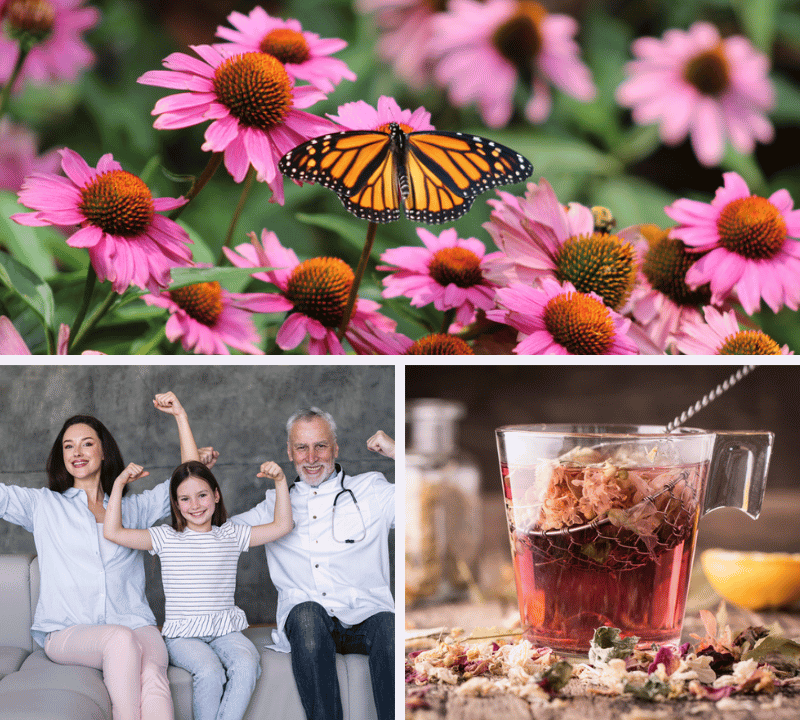
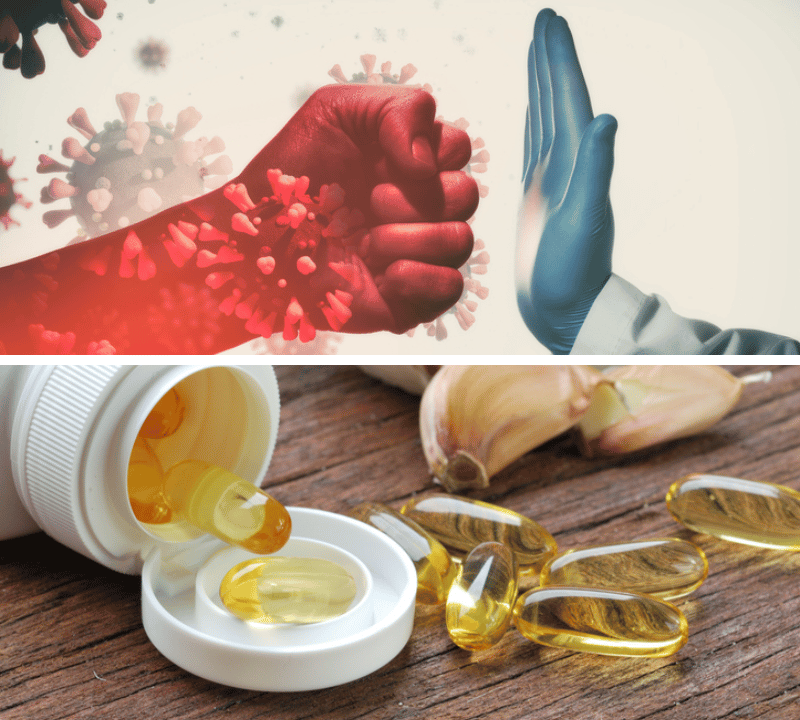
Member discussion